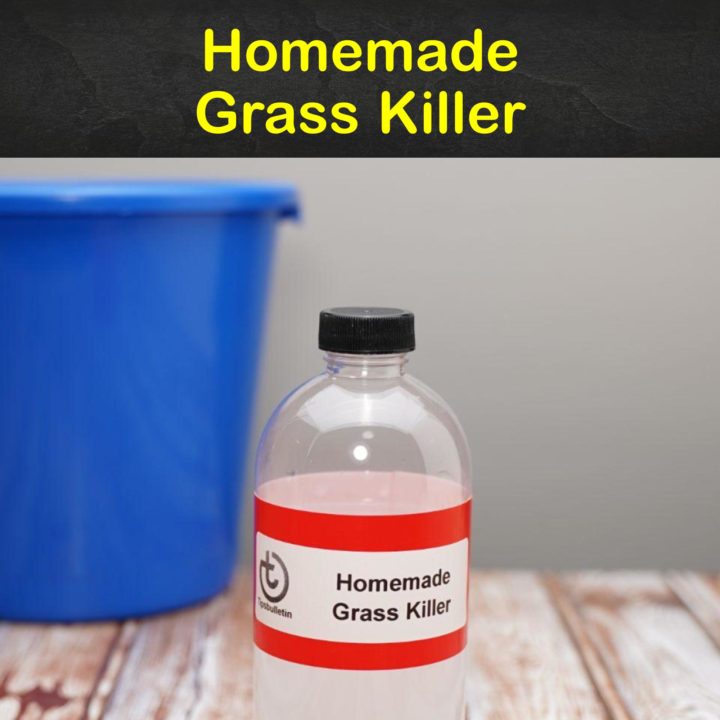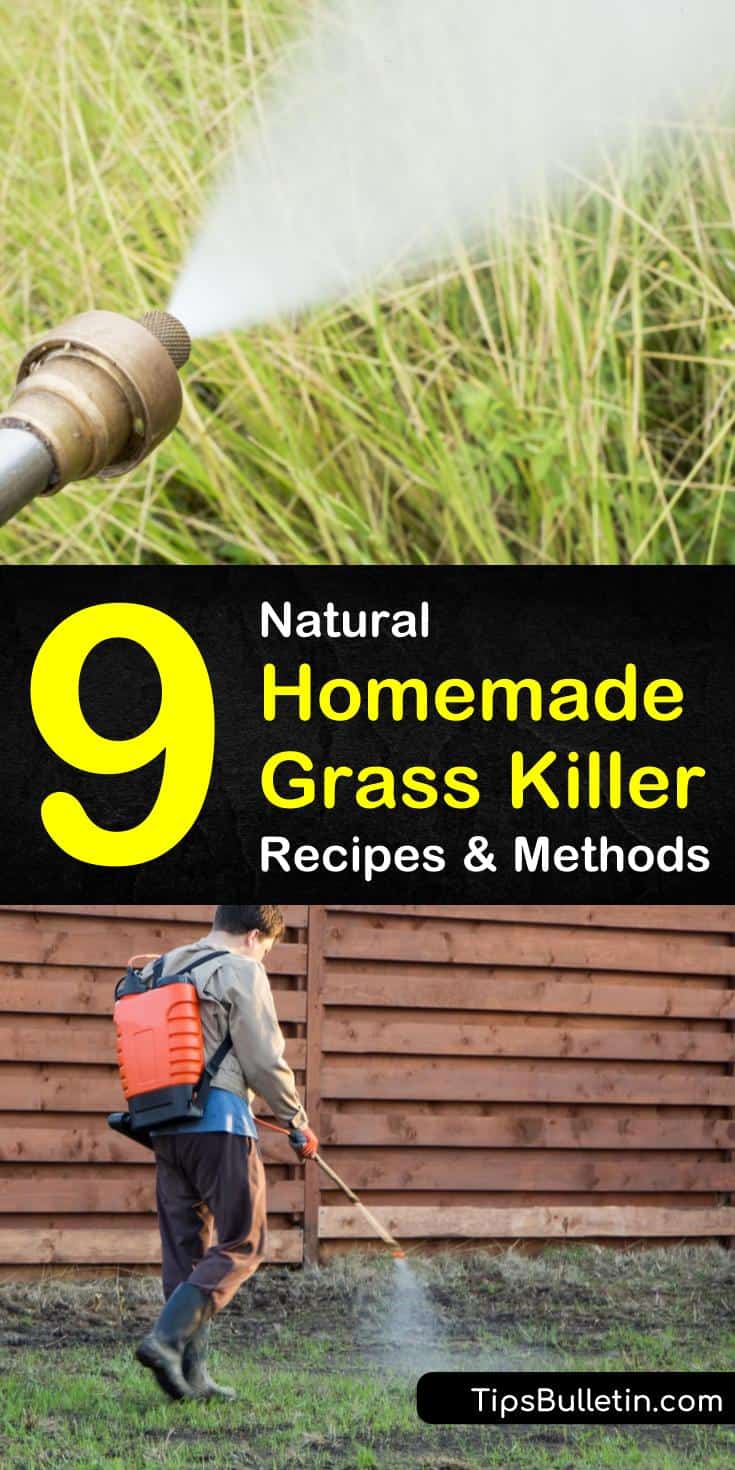Getting rid of unwanted grass in your yard may feel like a daunting task, but you can accomplish it if you know the right tricks. The key to killing weeds and grass permanently is to eliminate their root systems. We have made a list of our favorite homemade grass killer recipes to help you remove grass naturally.
There are several reasons you may want to kill grass or remove an existing lawn, and these can include putting in a vegetable garden or starting a new lawn from scratch to eliminate overgrown weeds.
Commercial herbicides such as Roundup can contain the active ingredient, glyphosate. The use of this chemical as a grass killer or to remove ground cover may not only be harmful to the environment but to those that come into contact with it.

- Homemade Grass Killer
- How to Make a Natural Grass Killer Spray
- Making a DIY Grass and Weed Killer
- How to Kill Bermuda Grass and Tough Grass
- Killing Grass in the Driveway
- DIY Grass Killer and Weed Control
- How to Use Water to Kill Grass
- How to Remove Grass by Hand
- How to Prevent Grass from Growing Back
- Regular Maintenance
- Recipe for Homemade Grass Killer
Homemade Grass Killer
There are two steps that you can take to kill and prevent grass and weeds. You can apply a natural pre-emergent herbicide to prevent the germination of weed seeds, or use at home ways to kill crabgrass and weeds with natural ingredients. We have several methods that you can make and use to safely remove unwanted grass from your yard.
How to Make a Natural Grass Killer Spray
Make a natural grass killer spray out of Borax and water. Borax is a natural herbicide that draws moisture out of the grass and weeds, eventually turning them brown and killing them. The following method is ideal to kill grass on a driveway or on large areas of grass.
You’ll get the best results if you use this solution on a sunny day. Combine the water and Borax in a bucket and mix well before pouring into a garden sprayer.
Spray the herbicide onto the grass in sections, using a sweeping motion until you have covered the entire area of undesirable grass. Use this simple recipe as the best way to get rid of clover, crabgrass, nutgrass, and other annoying weeds that grow where you don’t want them.
Making a DIY Grass and Weed Killer
Lawns that are not maintained properly can become overgrown with invasive weeds such as crabgrass, dandelions, and thistle. If your yard has more weeds than grass, your best bet is to kill the entire area and start over with a new lawn of grass. This DIY grass and weed killer will help you get started.

Solarizing Grass
Use a mower set to the lowest setting to mow the grass before solarizing, and then water the area thoroughly to saturate the soil. Lay large sheets of plastic over the top of the grassy areas and place heavy objects such as rocks or bricks along the corners and edges to increase the surface tension.
Leave the plastic in place for up to six weeks. The sun will heat the inside of the plastic, burning and killing the grass and weeds.
How to Kill Bermuda Grass and Tough Grass
Make a homemade weed and grass killer using household vinegar. White vinegar is a form of acetic acid that will burn the blades of grass and cause them to dry out. This recipe includes dish soap, which helps the vinegar adhere to the grass so that it is more effective.
Getting rid of weeds and killing moss with vinegar is easy. Combine Dawn liquid dish soap and water in a large bucket and mix well without creating suds, and then pour the herbicide solution into a garden sprayer.
On a sunny day with no wind, spray the liquid onto the grass in sections until you have covered the entire area. After a couple of days, you should begin to notice the grass turning brown.
If one application doesn’t do the trick, repeat the process. Use this remedy as an effective dandelion spray, too. Eliminate those unwelcome spots of yellow in the lawn with ease.
Killing Grass in the Driveway
Killing grass with vinegar and sodium chloride, otherwise known as salt, is like having the power of two in one. The vinegar dries the grass externally while the salt creates a water imbalance in the plant cells. This solution works well for clusters of unwanted grass, such as in the driveway or sidewalk.
Make sure that it is not a windy day while proceeding with this method. Combine the white vinegar and cup salt in a spray bottle. You can use table salt, rock salt, or Epsom salt to kill grass as an effective and natural herbicide.
Add a couple of squirts of dishwashing liquid into the container. The soap helps the salt and vinegar stick to the grass blades longer. Give the bottle a gentle shake and spray the solution directly onto the clumps of grass.
DIY Grass Killer and Weed Control
You can make a homemade vegetation killer using only one ingredient. Rubbing alcohol dehydrates plants and works great at killing grass and weeds, more so if applied on a hot, sunny day. We recommend using this method for small patches of unwanted grass and weeds.
Fill a bottle with rubbing alcohol and label it for safety reasons and future use. Spray the rubbing alcohol directly onto the blades of grass until they are saturated. Be sure that you do this on a day without wind to avoid indirectly spraying other vegetation. The grassy area should be withered and dead in a couple of days.
How to Use Water to Kill Grass
If you’d prefer trying the easiest method to kill weeds and grass instead of learning how to make a homemade weed killer, then the following process is for you. While grass needs water to survive, you can also use it as a tool to kill it. Here is a smart solution for removing small patches of unwanted grass.
Boiling Water Weed Killing
Bring a stockpot of water to boil and then pour the water into a watering can. What burns the grass can also burn your hands, so do this carefully.
Pour the hot water directly onto garden weeds and grass. Be careful to avoid splashing onto nearby plants or veggies if you’re working in the garden.
How to Remove Grass by Hand
If you’re a do it yourself kind of person and prefer not spraying anything onto your lawn, remove unwanted grass manually. While this can be challenging and requires a bit of elbow grease, it is one of the best ways to eliminate grass and grassroots.
Place the shovel tip into the ground at the edge of the grass, shove downward using the bottom of your foot, and then pry the grass sod upward. Repeat these steps in sections as you make your way around the area of unwanted grass.
You may want to wear garden gloves and use knee pads for weeding in this next step. Grab the chunks of grass and sod with your hands and pry them out of the ground. You may have to turn and twist the sod clump gently to loosen the roots.
Shake off the excess dirt, place the grass clumps into a wheelbarrow or bucket, and dispose of it in compost or other location. Use a garden rake to rake through the loose soil to check for any leftover grassroots. If you notice grubs while removing the grass and sod, you may need to make a homemade grub killer to eliminate them.
How to Prevent Grass from Growing Back
After you have removed grass from the yard to place a garden bed, take specific steps to ensure that the grass and weeds do not grow back.
Put down layers of newspaper and cardboard over the top of the soil where you do not want weeds and grass growing. Make the layers approximately a quarter-inch thick. Cover the newspaper and cardboard with two inches of mulch. You will need to repeat this process yearly due to decomposition.
If the garden is alongside a lawn of grass, add an edger or barrier to separate the grass from your flower or vegetable garden to stop the grass from spreading into the soft soil.
Regular Maintenance
To ensure that grass stays out of areas where you do not want it, go over the lawn periodically to see if any grass is popping up where it is not wanted. Treat strays immediately to prevent them from becoming a problem.
While getting rid of unwanted grass and weeds is probably not on the top of your favorite-things-to-do list, it should make you feel a little better knowing that it is not as difficult as you may have anticipated.
It should also put you at ease, learning that you can safely eliminate grass in the yard without spreading harmful chemicals. You can use everyday household items to free up yard space for your garden or clear your driveway from overgrown grass.
Recipe for Homemade Grass Killer

Homemade Grass Killer
Get rid of unwanted grass and weeds with ease.
Materials
- 2-quarts vinegar
- 4 tsp dishwashing liquid
Tools
- Bucket
- 1-gallon pump sprayer
- Stirrer
Instructions
- Mix the dish soap and vinegar in the bucket without too many bubbles.
- Pour the herbicide into the sprayer.
- Generously spray the area where you don't want grass or weeds.
- Repeat every 3 or 4 days as needed.
Notes
Grass and weeds should be completely dry, and no rain should be expected within 24 hours for ideal results.

Making a natural, homemade grass killer for freeing up space in your yard for a garden or clearing an overgrown driveway is not as complicated as you may have thought, so why not share these grass killer recipes with your family and friends on Pinterest and Facebook?